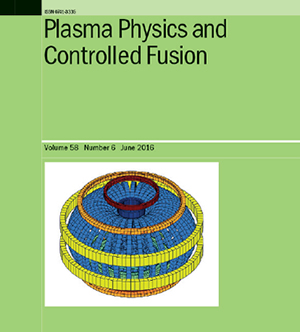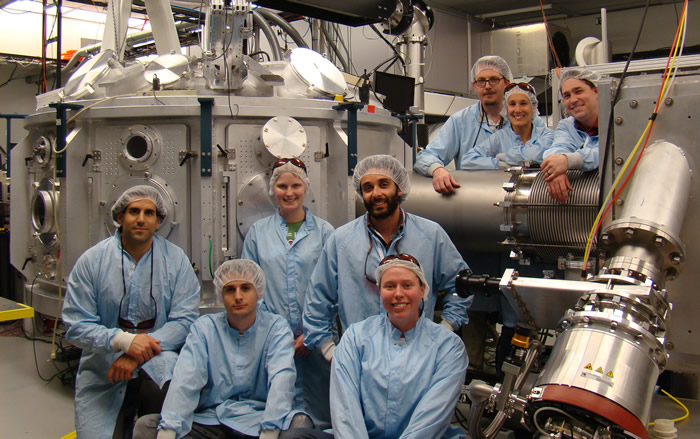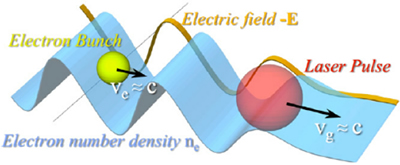Papers and Presentations - 2017
February
The Viral Popularity of LLNL’s Laser-Accelerator Research
The pioneering work of LLNL physicist Félicie Albert has earned the plasma physics equivalent of going viral: Her paper on the wide-ranging potential for laser-accelerated light sources was among the most popular downloads of the year published by the international publishing giant, IOP (Institute of Physics) Science.

Albert, of the NIF & Photon Science Directorate, is lead author of the paper that earned a spot in what IOP calls its “exclusive Highlights of 2016 collection,” offering open access to more readers for another year. “Papers are chosen to represent the excellence and breadth of the work published in 2016,” said UK-based publisher Alice Malhador of Plasma Physics and Controlled Fusion in announcing the selection of Albert’s paper out of hundreds published by the journal.
“It’s great to see this work being recognized for the wide potential it offers to so many disciplines,” said Albert, who joined the Laboratory in 2008 as a postdoctoral researcher and in 2010 as a permanent member of the scientific staff. Albert is known internationally as an innovator and expert in research related to the generation of radiation sources from laser-plasma and laser-electron acceleration. Last year she was selected by the Department of Energy’s Office of Fusion Energy Sciences to receive funding as part of DOE’s Early Career Research Program.
 The Betatron X-Ray Team at the Jupiter Laser Facility’s Titan Laser. Front row, from left: Will Schumaker, SLAC National Accelerator Laboratory; Clément Goyon, LLNL; Alison Saunders, UC Berkeley; Nuno Lemos, LLNL; and Jessica Shaw, Laboratory for Laser Energetics, University of Rochester. Back row, from left: Scott Andrews, Félicie Albert, and Brad Pollock, LLNL.
The Betatron X-Ray Team at the Jupiter Laser Facility’s Titan Laser. Front row, from left: Will Schumaker, SLAC National Accelerator Laboratory; Clément Goyon, LLNL; Alison Saunders, UC Berkeley; Nuno Lemos, LLNL; and Jessica Shaw, Laboratory for Laser Energetics, University of Rochester. Back row, from left: Scott Andrews, Félicie Albert, and Brad Pollock, LLNL. Albert spent nearly a year working on the 36-page review paper, “Applications of laser wakefield accelerator-based light sources,” with co-author Alec G. R. Thomas of Lancaster University in the UK. Their paper focuses on the scientific breakthroughs in laser wakefield acceleration-driven light source research, and development of the immense potential for the technology-enabling advances in everything from high-energy radiography to nuclear medicine to semiconductors to defense and industrial applications. It holds potential in advancing research in high energy density (HED) science as well as wide-impact areas such as energy storage, detection of explosives and drugs in cargo, and the solidity of welded structures such as pipes.
The Lab’s betatron x-ray work is one of the promising light sources driven by laser-wakefield acceleration; a recent Science & Technology Review article highlighted Livermore’s research into materials subjected to extreme conditions of heat and pressure and advances in the field by Albert’s team.
 Principle of laser wakefield acceleration, showing the laser pulse, accelerated electron bunch, and longitudinal electrical field. Credit: A.G.R. Thomas, Lancaster University
Principle of laser wakefield acceleration, showing the laser pulse, accelerated electron bunch, and longitudinal electrical field. Credit: A.G.R. Thomas, Lancaster University Superfast X-ray Imaging
Albert works with some of the fastest x-ray imaging tools ever developed. “It allows us to take snapshots of ultrafast phenomena happening on the atomic scale,” she explains, “like an exceptionally high-speed camera for atoms except it’s a probe. It can be a very powerful tool to diagnose high energy density science phenomena with various techniques, such as imaging or spectroscopy.”
Electrons traveling at nearly the speed of light can be accelerated in a laser-driven plasma channel, a process known as laser-wakefield acceleration. Several methods, described in the paper, allow these electrons to produce various forms of radiation, from terahertz to x rays to gamma rays. Radiation produced in this manner is femtoseconds in duration—as fast as a quadrillionth of a second—directional, spatially coherent, and broadband, making it highly attractive as a probe.
To produce betatron x rays, one of the sources described in the paper and the main focus of Albert’s current work, a high-powered laser pulse strips electrons from the molecules of a gas, creating a plasma consisting of a cloud of positively charged ions and free electrons. The free electrons are pushed aside by the laser light, and some circle back behind the pulse to be captured in the positively charged ion bubble in the pulse’s wake. The oscillating “wakefield” electrons produce high-energy x rays in the femtosecond regime that are synchronous with the initial laser pulse.
Albert’s work has been funded by the Laboratory Directed Research and Development program as well as the DOE Office of Science Early Career Research Program and the Office of Fusion Energy Sciences.



